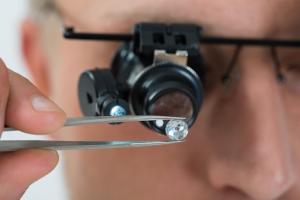4 steps for a worry-free appraisal

Inflation and rising costs can affect more than just your home – they can also impact your wedding ring, expensive watch, coin collection, sporting equipment, musical instruments and more.
The best way to ensure the value of your personal items is as current as possible is to have them appraised every 3-5 years – more often for items of greater value.
Follow these simple steps to start your appraisal process:
1. Identify a certified expert
Every industry has a different set of professional standards and field of experts. There are three organizations that are a great place to start: Appraisers Association of America, American Society of Appraisers and International Society of Appraisers. Whatever appraiser you choose, make sure they are properly certified.
2. Schedule an in-person appraisal
While some appraisals can be done remotely with some degree of accuracy, your best bet is to schedule an appraiser to look at your valuables, so they can see the items in person and lend their expertise to any issues.
3. Document and protect your valuables
Whether you bought or inherited your valuables, you’ll need proof of ownership – meaning you’ll need to protect the paperwork almost as much as the item. Keep your receipts, take photos of your valuables and keep them in a safe. Some appraisers will take pictures as part of the appraisal process, but it is equally important for you to take and save photos for your own records.
4. Ensure you’re insured
In the event your items are lost or stolen, you’ll want valuable items coverage from a carrier like The Hanover to replace them. And if you already have coverage, make sure you are not underinsured. According to Artigem, 55% of insured valuable items don't have enough coverage to be fully replaced in the event of a claim. Talk to your independent insurance agent about the right coverage options for you.
Sources
Related resources
4 steps for a worry-free appraisal
Inflation and rising costs can affect more than just your home – they can also impact your wedding ring, expensive watch, coin collection, sporting equipment, musical instruments and more.
The best way to ensure the value of your personal items is as current as possible is to have them appraised every 3-5 years – more often for items of greater value.
Follow these simple steps to start your appraisal process:
1. Identify a certified expert
Every industry has a different set of professional standards and field of experts. There are three organizations that are a great place to start: Appraisers Association of America, American Society of Appraisers and International Society of Appraisers. Whatever appraiser you choose, make sure they are properly certified.
2. Schedule an in-person appraisal
While some appraisals can be done remotely with some degree of accuracy, your best bet is to schedule an appraiser to look at your valuables, so they can see the items in person and lend their expertise to any issues.
3. Document and protect your valuables
Whether you bought or inherited your valuables, you’ll need proof of ownership – meaning you’ll need to protect the paperwork almost as much as the item. Keep your receipts, take photos of your valuables and keep them in a safe. Some appraisers will take pictures as part of the appraisal process, but it is equally important for you to take and save photos for your own records.
4. Ensure you’re insured
In the event your items are lost or stolen, you’ll want valuable items coverage from a carrier like The Hanover to replace them. And if you already have coverage, make sure you are not underinsured. According to Artigem, 55% of insured valuable items don't have enough coverage to be fully replaced in the event of a claim. Talk to your independent insurance agent about the right coverage options for you.
Sources
Related resources
4 steps for a worry-free appraisal
Inflation and rising costs can affect more than just your home – they can also impact your wedding ring, expensive watch, coin collection, sporting equipment, musical instruments and more.
The best way to ensure the value of your personal items is as current as possible is to have them appraised every 3-5 years – more often for items of greater value.
Follow these simple steps to start your appraisal process:
1. Identify a certified expert
Every industry has a different set of professional standards and field of experts. There are three organizations that are a great place to start: Appraisers Association of America, American Society of Appraisers and International Society of Appraisers. Whatever appraiser you choose, make sure they are properly certified.
2. Schedule an in-person appraisal
While some appraisals can be done remotely with some degree of accuracy, your best bet is to schedule an appraiser to look at your valuables, so they can see the items in person and lend their expertise to any issues.
3. Document and protect your valuables
Whether you bought or inherited your valuables, you’ll need proof of ownership – meaning you’ll need to protect the paperwork almost as much as the item. Keep your receipts, take photos of your valuables and keep them in a safe. Some appraisers will take pictures as part of the appraisal process, but it is equally important for you to take and save photos for your own records.
4. Ensure you’re insured
In the event your items are lost or stolen, you’ll want valuable items coverage from a carrier like The Hanover to replace them. And if you already have coverage, make sure you are not underinsured. According to Artigem, 55% of insured valuable items don't have enough coverage to be fully replaced in the event of a claim. Talk to your independent insurance agent about the right coverage options for you.
Sources
Related resources
4 steps for a worry-free appraisal
Inflation and rising costs can affect more than just your home – they can also impact your wedding ring, expensive watch, coin collection, sporting equipment, musical instruments and more.
The best way to ensure the value of your personal items is as current as possible is to have them appraised every 3-5 years – more often for items of greater value.
Follow these simple steps to start your appraisal process:
1. Identify a certified expert
Every industry has a different set of professional standards and field of experts. There are three organizations that are a great place to start: Appraisers Association of America, American Society of Appraisers and International Society of Appraisers. Whatever appraiser you choose, make sure they are properly certified.
2. Schedule an in-person appraisal
While some appraisals can be done remotely with some degree of accuracy, your best bet is to schedule an appraiser to look at your valuables, so they can see the items in person and lend their expertise to any issues.
3. Document and protect your valuables
Whether you bought or inherited your valuables, you’ll need proof of ownership – meaning you’ll need to protect the paperwork almost as much as the item. Keep your receipts, take photos of your valuables and keep them in a safe. Some appraisers will take pictures as part of the appraisal process, but it is equally important for you to take and save photos for your own records.
4. Ensure you’re insured
In the event your items are lost or stolen, you’ll want valuable items coverage from a carrier like The Hanover to replace them. And if you already have coverage, make sure you are not underinsured. According to Artigem, 55% of insured valuable items don't have enough coverage to be fully replaced in the event of a claim. Talk to your independent insurance agent about the right coverage options for you.
Sources





